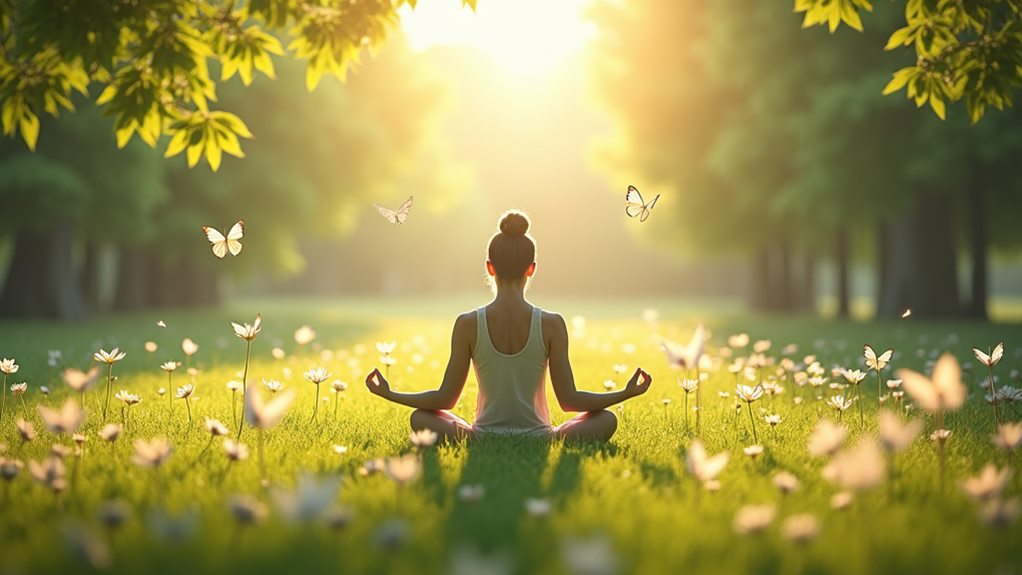
Embarking on your mindfulness journey is all about embracing the present moment with a gentle, open mind. Start with simple practices like observing your breath and doing body scans to reduce stress and boost focus. Meditation isn’t an escape; it’s a way to savor inner peace by aligning your mind with your body. Even mundane activities, like eating or walking, become profound experiences when done mindfully. These practices won’t just lift your mood—they’ll improve your brain’s function and emotional balance. This beginner’s guide is your gateway to unlocking a more centered and enriched life. Want to grasp these tools? Let’s begin.
Understanding Mindfulness
When you truly grasp what mindfulness means, you’re uncovering a powerful, transformative tool right at your fingertips. It’s about diving headfirst into the present moment with a gentle awareness that’s non-judgmental. Engaging in mindful practices can elevate your mood and help you focus more on the present moment. You’re tuning into your thoughts and feelings, observing them as they ebb and flow, without jumping to conclusions or judgements.
Practicing mindfulness doesn’t require you to empty your mind; instead, it encourages you to embrace what’s there. Picture it as giving your mind a front-row seat to a grand performance—your life. Through techniques like body scans and breath observation, you’re not just living in autopilot mode. You’re consciously stepping into each moment, reducing stress and enhancing your daily life.
Imagine being able to tackle the chaos of your day with a clear lens of awareness. As mindfulness reshapes the brain’s landscape, it bolsters your cognitive functions and emotional regulation. It’s like a secret weapon you can carry wherever you go, accessible anytime, anywhere. So, why not dive into this practice head-on? Bring mindfulness into your routine, enrich your reality, and observe your inner world with clarity. Your journey toward mindful living starts now.
Basics of Meditation
Let’s dive into the basics of meditation and explore how it can transform your mental landscape. Meditation isn’t just a trendy buzzword; it’s an intimate exploration of your mind. Imagine engaging deeply with your sensations, emotions, and thoughts without judgment. Sounds liberating, right? For starters, consider your breath as your trusty anchor. This beginners guide urges you to let your breath guide your wandering mind back to the present moment, gently nudging your attention away from distractions. Including breathing techniques as part of your meditation practice can quickly alleviate stress, making the journey even more rewarding.
A comfortable, stable posture isn’t just for aesthetics—sitting with a relaxed body and softening your gaze can enhance your mindfulness. As you settle, you’ll notice physical sensations you’ve often ignored. This practice leads to increased focus and emotional regulation, especially if you commit to just 10 minutes of regular mindfulness practice daily. Yes, that’s all it takes to witness profound changes in your well-being!
Consider adding body scans and loving-kindness practices to your regimen. These techniques deepen self-awareness and build compassion toward yourself and others. With patience and persistence, you’ll turn meditation into a powerful tool for emotional regulation and heightened awareness, enriching every facet of your life. Give it a shot—your mind will thank you.
Breath Awareness Techniques

Breath awareness techniques often weave simplicity with profound impact, making them a cornerstone of effective meditation practice. You’ve got an incredible tool right under your nose—your breathing. Start by sitting comfortably, keeping your posture straight. Close your eyes, or soften your gaze, and focus your attention on the way your breath naturally flows in and out. Feel the breath—don’t try to control it, just observe. This simple act is more powerful than it seems, helping you cultivate daily mindfulness. By consistently engaging in this practice, you can decrease mental chatter and foster a calmer mind. As thoughts inevitably creep in, don’t worry. It’s normal. Acknowledge these thoughts without judgment; then gently redirect your focus back to your breathing. This routine is gold for mental health: it helps reduce stress and sharpens your concentration. Give your brain a chance to take a break—practicing breath awareness for just 5-10 minutes a day makes a noticeable difference.
Research backs this up: regular breath-focused mindfulness isn’t just a fluffy wellness buzzword. It can lead to reduced anxiety and better overall well-being. By consistently anchoring yourself in the rhythm of your breath, you’re not just relaxing—you’re crafting an effective mental reset button. Try it, and watch the benefits unfold.
Body Scan Practice
The body scan practice is your ticket to a deeper connection with yourself and a break from the chaos of everyday life. It’s as simple as systematically bringing awareness to different parts of your body, starting from the toes and working your way up to the head. This isn’t your usual mind-numbing meditation; it demands you to truly notice—without judgment—whatever sensations, tension, or discomfort you encounter along the way. What you’re really doing here is nurturing acceptance and mindfulness.
Need to reduce stress? Rely on the body scan practice for deep relaxation. As you tune into your bodily sensations, you’ll foster greater emotional regulation. It’s a transformative habit. Studies show that regular indulgence in this practice doesn’t just calm your nerves, but brings forth improved mental health outcomes by reducing anxiety and depression. Picture this as a mental reset button that takes only 10 to 30 minutes—make it a daily rendezvous.
Mindful Eating Tips

Ever find yourself eating without even tasting your food? You’re not alone. It’s easy to lose touch with the sheer delight of eating when life’s distractions pull you away. Mindful eating, though, can change all that. When you eat, pay full attention to each bite. Notice the taste, texture, and aroma of your meal. This simple shift can transform meals from mundane fuel stops into opportunities for genuine enjoyment.
Start by taking a moment to appreciate your food. Look at its colors, savor its aroma. Gratitude practices, like reflecting on where your food came from, can deepen this appreciation. Next, eat slowly. Resist the urge to multitask. Put down your phone, turn off the TV, and just focus on your plate. Eating without distractions helps you tune into your body’s hunger cues, preventing overeating and fostering a positive relationship with food.
Listen to your body as you eat. Are you truly hungry, or are other emotions dictating your eating? Recognizing this helps you distinguish between hunger and habits. Engage fully in each meal, and you’ll find not only better digestion but also a renewed, richer experience with food.
Walking Meditation Steps
Imagine a practice that turns a simple walk into a journey of mindfulness and awareness. That’s walking meditation for you. Start by finding a quiet space where you can walk slowly and focus on each physical sensation. Feel your feet and legs connect with the ground. Each step becomes a dance of awareness.
Next, coordinate your breath with your steps. Try inhaling for four steps, then exhaling for another four. This rhythmic flow anchors your attention, making the walking meditation a truly intentional experience. Keep your posture upright, with relaxed shoulders and a soft gaze forward. This helps you stay in the present moment, fully attuned to your breath and body.
Now, here’s a challenge—when your mind wanders (and it will), don’t worry. Simply acknowledge those thoughts and gently redirect focus back to the rhythm of your breath and the sensations in your body. End the practice by stopping, taking a few deep breaths, and observing how your surroundings feel. Notice how your body responds after indulging in this walking meditation. You’ve turned a simple walk into an enriching experience of mindfulness and awareness.
Gratitude Meditation Guide

Having immersed yourself in the mindful steps of walking meditation, let’s now turn your attention inward to an equally enriching practice—gratitude meditation. Imagine kickstarting your day by focusing on positive aspects of your life. It’s not just about appreciating the good; it’s about transforming how your brain works. Gratitude meditation—simple yet profound—leads to noticeable mental health outcomes by reducing symptoms of anxiety and depression. Ready to dive in?
First, find a quiet space where you won’t be disturbed. Close your eyes and take deep breaths. Inhale calm, exhale stress. Now, visualize experiences or people you’re thankful for. Picture these vividly, allowing feelings of gratitude to flood your being. Feel your neural pathways firing up, crafting a resilient, optimistic brain. As you practice this, you’ll notice a growing sense of peace and contentment enveloping you.
Make it a habit. Spend a few minutes each day reflecting on just three things you’re grateful for, and watch how this simple act transforms your life. By embracing gratitude meditation, you’re not just altering thoughts; you’re shifting toward a healthier, more fulfilling existence. Let gratitude start paving the way today.
Managing Anxiety With Mindfulness
You’re not alone in feeling the weight of anxiety, and thankfully, mindfulness can be your secret weapon. By embracing mindfulness techniques like breath awareness and body scans, you’re not just observing your thoughts; you’re reshaping your relationship with them. Imagine having the power to observe without judgment and cut short the cycle of negative rumination. That’s mindfulness in action for managing anxiety.
Mindfulness meditation practice isn’t just a self-help gimmick. Research shows it can lower your cortisol levels, the hormone responsible for your stress, paving the way for emotional regulation. This creates a more balanced mental state where anxiety doesn’t wield as much power. By sharpening your present-moment awareness, you can pinpoint anxiety triggers and develop more effective coping strategies.
The benefits of mindfulness don’t stop at just temporary relief. Mindfulness-based interventions have been proven to reduce anxiety symptoms significantly, with effects that last well beyond the initial phase. You end up feeling more in control of your emotions and thoughts, giving you a much-needed breather from the chaos. It’s not about escaping anxiety but mastering it with grace and resilience. So, start practicing mindfulness today and step into your own power.
Sleep Meditation Practices

Many people underestimate the power of sleep meditation, but it’s a game-changer for those struggling to get a good night’s rest. If you’re tossing and turning, guided meditation can be your secret weapon. It only takes about 20 minutes and uses soothing techniques like deep breathing and body scans to calm your mind. When you practice mindfulness through sleep meditation, you’re not just chasing the elusive sleep quality; you’re embracing a proven way to combat insomnia symptoms.
Don’t think you need a spa-like sanctuary to get started. Simply find a quiet place where you can be undisturbed. Apps and online resources are your best friends here; they offer a wide range of guided meditations perfect for your nightly routine.
Picture this: you’re lying down in a comfortable position, eyes gently closed, and focusing on your breath. As you inhale and exhale deeply, the guided meditation takes you through calming visualizations and a body scan, melting away tension. The result? You’ll drift into that peaceful mental environment everyone craves. With regular practice, you’ll notice improved sleep duration and quality, allowing you to wake up refreshed and ready to tackle the day.
Group Mindfulness Sessions
Community is at the heart of group mindfulness sessions, turning what can often feel like a solo journey into a shared adventure. You’re not just meditating alongside others; you’re building a support network that boosts your commitment to consistent practice. An experienced teacher can lead the group, or you might opt for rotating leadership, sparking diverse perspectives and enriching your shared learning experiences. It’s all about mixing it up and finding what clicks best for the community.
Don’t underestimate the power of structure in these meditation sessions. Set a specific duration—say 15, 30, or 45 minutes—so everyone knows what to expect and can commit fully. Starting with mindful breathing exercises sets the stage, helping everyone settle in and create a calm atmosphere. It’s your breathing ticket to focus.
But here’s the kicker: sharing experiences afterwards. Engaging in collective reflection isn’t just a nice-to-have; it’s essential for growth. Taking the time to discuss insights nurtures a supportive environment, reinforcing the benefits of mindfulness in a real, tangible way. Think of it as turning individual moments of clarity into collective understanding, a cornerstone of mindful community practice.
Mindfulness Benefits Overview

Diving into the benefits of mindfulness is like opening a treasure chest of insights for your well-being. You’ll discover how mindfulness not only decreases stress but also transforms your mental health. Imagine lowering those pesky cortisol levels, which leads to less anxiety and depression. And it’s not magic; it’s mindfulness meditation at work.
Here’s what you gain with regular mindfulness techniques:
- Enhanced Emotional Regulation: You’ll face challenging situations with grace, mastering the art of responding rather than reacting. Mindfulness boosts your emotional regulation skills to navigate life’s storms calmly.
- Improved Self-Awareness: With mindfulness, you get to know yourself better—warts and all. Recognize thoughts and feelings without judgment, paving the way for positive changes. Self-awareness is key to your transformation.
- Better Focus and Attention: Your mind becomes a laser, slicing through distractions. This improved focus isn’t just good for those endless emails but also enhances your overall well-being, affecting everything from your sleep quality to resilience against stress-related illnesses.
Trust science—mindfulness enriches cognitive performance and contributes to long-term health. Dive into mindfulness and experience these undeniable benefits firsthand. Are you ready to transform your life?
Common Misconceptions
Let’s clear the air—mindfulness often gets tangled up in misunderstandings that can cloud its true essence. You might think it’s about clearing your mind completely, but that’s a major misconception. Mindfulness exercises revolve around observing thoughts and feelings without judgment. It’s about allowing your mind to wander and then gently redirecting focus to the present moment.
Many also mistakenly believe mindfulness is solely a spiritual or religious activity. In truth, it’s a secular practice open to everyone. Cultivating mindfulness doesn’t require chanting or incense; all you need is your willingness to engage with your present experiences fully.
Another myth suggests that mindfulness is a quick fix for stress and anxiety. The reality? Its benefits unfold through consistent practice over time. By embracing mindfulness, you learn to move through life with greater awareness and acceptance—it’s not about escaping your reality but being immersed in it.
You might also worry about doing it “wrong,” but there isn’t a right or wrong way. Whether through mindful movement or simply sitting quietly, it’s about acknowledging your mind’s wanderings and returning gently to the here and now. Mindfulness is a personal journey, unique to you.
Mindfulness Resources

Access to a multitude of mindfulness resources means you can find guidance that’s as diverse as your needs. The world of mindfulness is bursting with options, whether you’re looking to reduce stress, improve mental health, or even become a meditation teacher. Here’s how you can start enriching your life with mindfulness:
- Mindfulness Apps: Embrace technology with apps offering guided meditations and breathing exercises. They provide daily reminders and track your progress, making it easier to incorporate mindfulness into your life seamlessly.
- Structured Mindfulness Courses: Consider enrolling in courses that teach Mindfulness-Based Stress Reduction techniques. These courses are designed for gradual learning, and many offer accredited certifications upon completion, which can be a game-changer if you’re considering teaching.
- 100 Day Mindfulness Challenge: Accept the challenge! Utilize online platforms like Mindful Radio, offering thousands of guided meditations to relieve stress and boost your mental health one day at a time.
Embarking on these resources is not just a task; it’s an invitation to transform your life. What’s holding you back? Deepen your knowledge and turn curiosity into action. You might find yourself changing not just your routine, but your entire perspective.
Start Your Mindful Journey Today
Embarking on a mindfulness journey is a small but significant step toward fostering a healthier and more balanced life. Starting with just a minute each day to focus on your breath, you can gradually build this practice into a fulfilling routine. Creating a dedicated space free from distractions is crucial for maximizing the benefits of mindfulness, as it becomes a sanctuary that enhances your focus and relaxation. By integrating mindfulness into everyday activities like eating and walking, you imbue even the mundane with meaning, embedding awareness seamlessly into your daily life without requiring additional time.
Guided meditations and mindfulness apps provide invaluable support, especially for beginners, by offering structured practices and maintaining engagement. They serve as tools that nurture your commitment and help you understand that mindfulness is a journey of observing your thoughts and emotions without judgment, rather than achieving an ideal mental state. This understanding enriches your mindfulness practice by fostering a deeper awareness and connection with your mental and emotional processes. With persistence and patience, mindfulness becomes a powerful ally, helping you to navigate life’s challenges with greater calm, clarity, and resilience. Ultimately, this journey not only enhances personal well-being but also opens pathways to deeper connections with those around you, enriching every aspect of your life.













